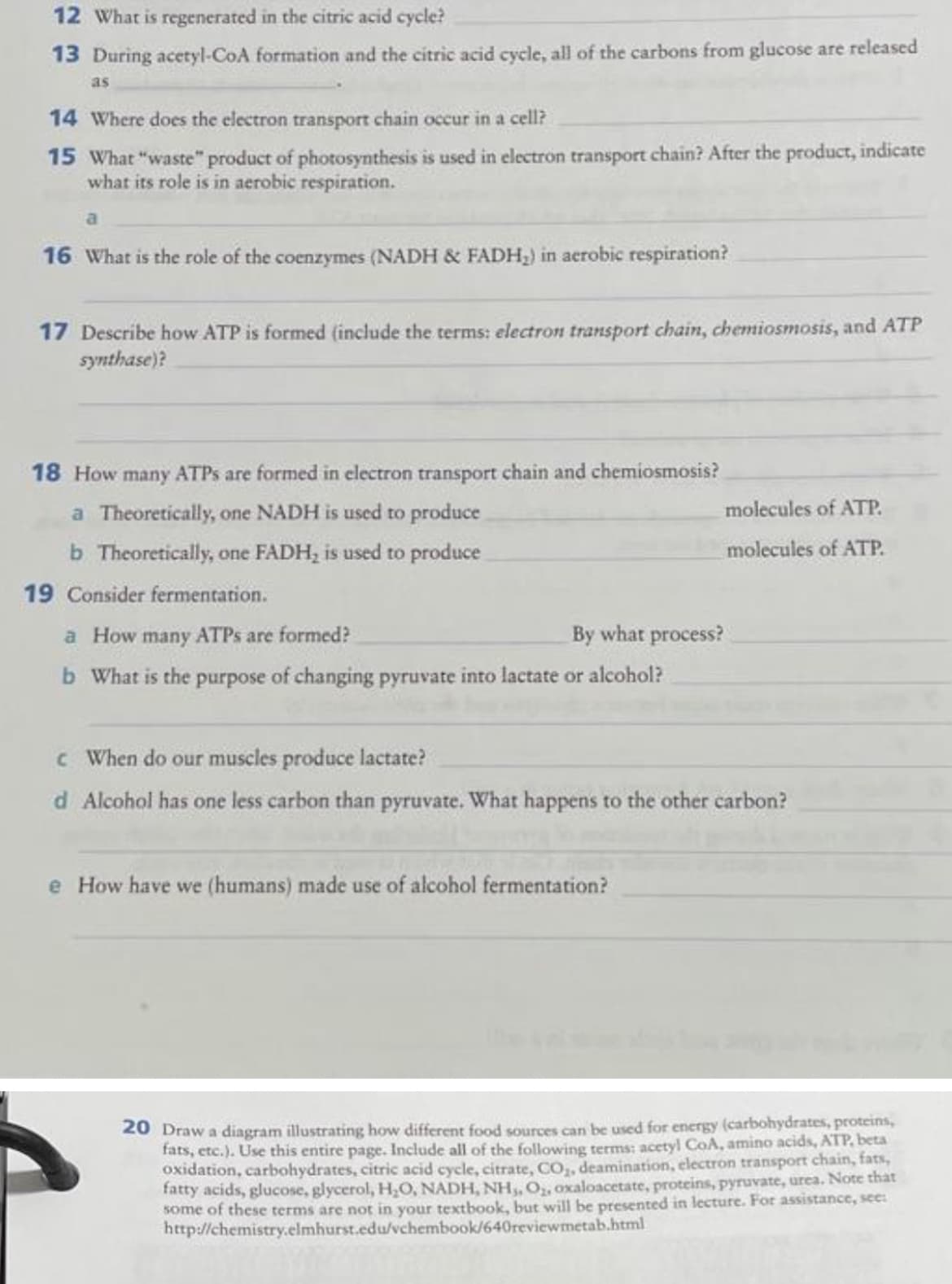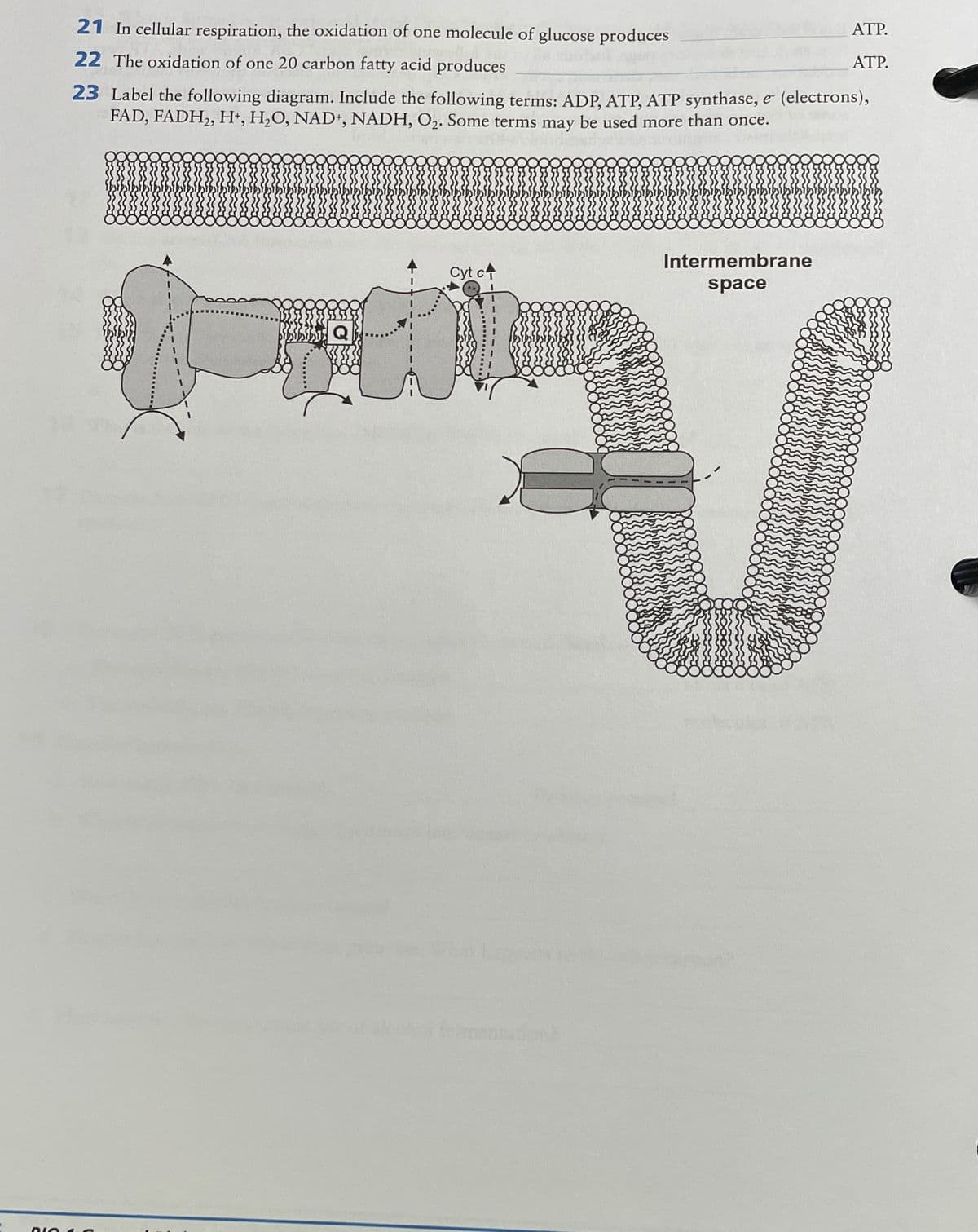12 What is regenerated in the citric acid cycle? 13 During acetyl-CoA formation and the citric acid cycle, all of the carbons from glucose are released as 14 Where does the electron transport chain occur in a cell? 15 What "waste" product of photosynthesis is used in electron transport chain? After the product, indicate what its role is in aerobic respiration. 16 What is the role of the coenzymes (NADH & FADH,) in aerobic respiration?
12 What is regenerated in the citric acid cycle? 13 During acetyl-CoA formation and the citric acid cycle, all of the carbons from glucose are released as 14 Where does the electron transport chain occur in a cell? 15 What "waste" product of photosynthesis is used in electron transport chain? After the product, indicate what its role is in aerobic respiration. 16 What is the role of the coenzymes (NADH & FADH,) in aerobic respiration?
Biology: The Dynamic Science (MindTap Course List)
4th Edition
ISBN:9781305389892
Author:Peter J. Russell, Paul E. Hertz, Beverly McMillan
Publisher:Peter J. Russell, Paul E. Hertz, Beverly McMillan
Chapter8: Photosynthesis
Section: Chapter Questions
Problem 10TYK: Animal metabolism and plant metabolism are related in that: a. plants carry out photosynthesis and...
Related questions
Question

Transcribed Image Text:12 What is regenerated in the citric acid cycle?
13 During acetyl-CoA formation and the citric acid cycle, all of the carbons from glucose are released
as
14 Where does the electron transport chain occur in a cell?
15 What "waste" product of photosynthesis is used in electron transport chain? After the product, indicate
what its role is in aerobic respiration.
16 What is the role of the coenzymes (NADH & FADH;) in aerobic respiration?
17 Describe how ATP is formed (include the terms: electron transport chain, chemiosmosis, and ATP
synthase)?
18 How many ATPS are formed in electron transport chain and chemiosmosis?
a Theoretically, one NADH is used to produce
molecules of ATP.
b Theoretically, one FADH, is used to produce
molecules of ATP.
19 Consider fermentation.
a How many ATPS are formed?
By what process?
b What is the purpose of changing pyruvate into lactate or alcohol?
c When do our muscles produce lactate?
d Alcohol has one less carbon than pyruvate. What happens to the other carbon?
e How have we (humans) made use of alcohol fermentation?
20 Draw a diagram illustrating how different food sources can be used for energy (carbohydrates, proteins,
fats, etc.). Use this entire page. Include all of the following terms: acetyl CoA, amino acids, ATP, beta
oxidation, carbohydrates, citric acid cycle, citrate, CO,, deamination, electron transport chain, fats,
fatty acids, glucose, glycerol, H,0, NADH, NH,,O, oxaloacetate, proteins, pyruvate, urea. Note that
some of these terms are not in your textbook, but will be presented in lecture. For assistance, see:
http://chemistry.elmhurst.edu/vchembook/640reviewmetab.html

Transcribed Image Text:21 In cellular respiration, the oxidation of one molecule of glucose produces
ATP.
22 The oxidation of one 20 carbon fatty acid produces
ATP.
23 Label the following diagram. Include the following terms: ADP, ATP, ATP synthase, e (electrons),
FAD, FADH2, H*, H2O, NAD*, NADH, O2. Some terms may be used more than once.
Intermembrane
Cyt c4
space
femention
DIO a
Expert Solution
This question has been solved!
Explore an expertly crafted, step-by-step solution for a thorough understanding of key concepts.
This is a popular solution!
Trending now
This is a popular solution!
Step by step
Solved in 2 steps

Follow-up Questions
Read through expert solutions to related follow-up questions below.
Follow-up Question
Per molecule of pyruvate, how many molecules of CO2 are produced during acetyl-CoA formation and the citric acid cycle (Stages 2 and 3)?
Solution
Recommended textbooks for you

Biology: The Dynamic Science (MindTap Course List)
Biology
ISBN:
9781305389892
Author:
Peter J. Russell, Paul E. Hertz, Beverly McMillan
Publisher:
Cengage Learning

Biology: The Unity and Diversity of Life (MindTap…
Biology
ISBN:
9781305073951
Author:
Cecie Starr, Ralph Taggart, Christine Evers, Lisa Starr
Publisher:
Cengage Learning

Biology: The Unity and Diversity of Life (MindTap…
Biology
ISBN:
9781337408332
Author:
Cecie Starr, Ralph Taggart, Christine Evers, Lisa Starr
Publisher:
Cengage Learning

Biology: The Dynamic Science (MindTap Course List)
Biology
ISBN:
9781305389892
Author:
Peter J. Russell, Paul E. Hertz, Beverly McMillan
Publisher:
Cengage Learning

Biology: The Unity and Diversity of Life (MindTap…
Biology
ISBN:
9781305073951
Author:
Cecie Starr, Ralph Taggart, Christine Evers, Lisa Starr
Publisher:
Cengage Learning

Biology: The Unity and Diversity of Life (MindTap…
Biology
ISBN:
9781337408332
Author:
Cecie Starr, Ralph Taggart, Christine Evers, Lisa Starr
Publisher:
Cengage Learning

Biology (MindTap Course List)
Biology
ISBN:
9781337392938
Author:
Eldra Solomon, Charles Martin, Diana W. Martin, Linda R. Berg
Publisher:
Cengage Learning

Anatomy & Physiology
Biology
ISBN:
9781938168130
Author:
Kelly A. Young, James A. Wise, Peter DeSaix, Dean H. Kruse, Brandon Poe, Eddie Johnson, Jody E. Johnson, Oksana Korol, J. Gordon Betts, Mark Womble
Publisher:
OpenStax College